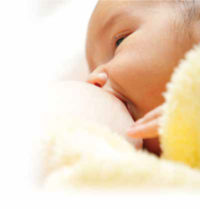Jaundice is a condition whereby the skin and the whites of the eyes turn yellowish, due to a high level of bilirubin in the blood. Bilirubin is a yellow substance normally produced when old red blood cells are broken down. It is then metabolised by the liver so that it can be removed from the body. About half of all newborns are affected by neonatal jaundice in the first few days of life.
In the transition after birth, foetal haemoglobin (HbF) will be destroyed, to be replaced by adult haemoglobin (HbA). The destruction of HbF releases iron and bilirubin. It is this excess bilirubin that causes physiological jaundice if the liver does not remove it. This is the most common cause of jaundice in newborns. It often manifests when the newborn is 2 to 4 days old and resolves within 2 weeks. It is usually harmless, if bilirubin levels remain stable.
If your newborn appears yellow, the paediatrician will do a blood test to measure his bilirubin level. If the condition is mild, you may continue to care for him as usual and are advised to breastfeed him regularly. This will encourage frequent bowel movements to remove bilirubin through the stools. Scheduled evaluations with the doctor may be needed.
A common treatment is by phototherapy, where the newborn is placed under a special blue light, which helps to break down excess bilirubin. Doctors may also recommend the therapy to be done at home. In severe cases, a blood exchange transfusion may be needed to prevent brain damage.
Myths and misconceptions
There are many misconceptions linked to jaundice. Here are facts behind some of the widely-believed myths.
Myth: Neonatal jaundice is caused by food, drugs, pregnancy conditions or inheritance from mother.
Fact: Based on current science, there is absolutely no link between these factors and neonatal jaundice. Jaundice is also highly unlikely to be passed down from mother to child. Apart from the mild jaundice that is physiological, severe neonatal jaundice may happen in rare occasions, caused by pathological conditions such as:
- Blood type mismatch between the mother and baby (i.e. when the mother has Rhnegative blood and her baby has Rh-positive blood; mother’s antibodies may enter baby’s blood through placenta and destroy his red blood cells, hence producing bilirubin). Even mothers with blood group O+ and baby of another blood group can cause baby to have jaundice.
- Babies with glucose-6-phosphate dehydrogenase (G6PD) deficiency.
- Abnormal blood cell shapes (e.g. sickle cell anaemia).
- Diseases that affect the liver and biliary tract (e.g. cystic fibrosis, hepatitis).
- Infections at birth (e.g. rubella, syphilis).
Myth: Neonatal jaundice is harmless and does not need any attention.
Fact: Most of the time, neonatal jaundice is harmless, but parents should always be concerned with the condition and keep track of the bilirubin level to prevent it from getting worse. A very high level of bilirubin can affect hearing and cause kernicterus, a form of brain damage. Immediately consult your doctor in any of these situations:
- Jaundice appearing within the first 24 hours of life (pathological jaundice).
- Rapid progression of jaundice
- Newborn screening result shows G6PD deficiency.
- Previous babies in your family have severe neonatal jaundice.
- Presence of pale coloured stools or dark urine.
- Your baby is born preterm.
Myth: Jaundice can be treated with sunlight therapy.
Fact: This is not advisable, as it is not effective and may be dangerous. A newborn may become dehydrated when placed under the sun, making the condition worse. Direct sunlight and UV rays can cause painful sunburn to the thin newborn skin.
Myth: Feed newborns with water to ‘flush out’ the jaundice.
Fact: Sometimes, newborns who are exclusively breastfed may have prolonged jaundice, but it is not a reason to stop breastfeeding or to supplement it with water. As long as breastfeeding mothers are not taking traditional medicine, and the baby is healthy and gaining weight, exclusive breastfeeding should be continued. In fact, mothers are recommended to nurse newborns at least 8 to 12 times a day during the first few days to tackle jaundice.
Myth: Goat’s milk can help in neonatal jaundice
Fact: There is no proper clinical study that shows goat’s milk is effective for neonatal jaundice. Moreover, the newborns’ digestive system and liver are still immature and unable to digest goat’s (and cow’s) milk, both of which do not have the right nutrients required, compared to breastmilk.
Myth: Newborns afflicted with jaundice may get it later in life.
Fact: Most neonatal jaundice cases are physiological and only happen during the first few days of life. Jaundice that manifests later in life has no link to neonatal jaundice.
As common as it may be, neonatal jaundice can still lead to severe complications, if it is not managed and treated properly. Proper consultation with your child’s paediatrician to keep track of his jaundice is vital during the first few days of life. Clarify your doubts with your doctor to avoid inaccurate information related to the condition.
An educational contribution by Malaysian Paediatric Association.







Comments